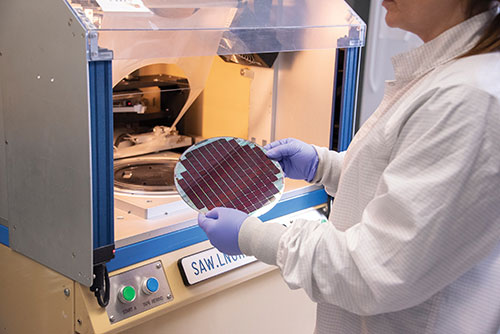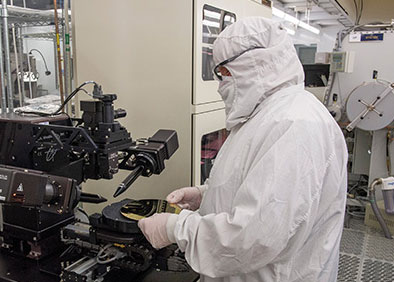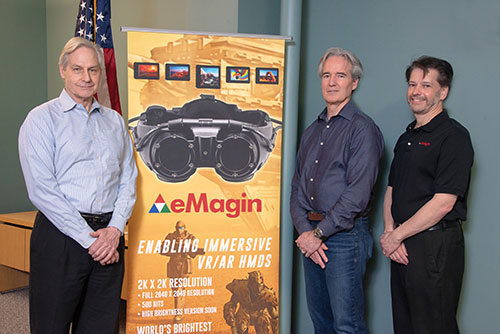eMAGIN CORPORATION | By Alison Butler
As a business that supports contractors for defense and national security, eMagin is classified as essential during the COVID-19 pandemic and we are continuing with production. However, in the interest of the well-being of our employees, we are strongly encouraging employees that have the ability to work from home to do so and for those where the ability to work from home is limited or not possible, to work alternative shifts to significantly reduce the on-site population at peak times. We have also increased the cleaning frequency of our facility are practicing the social distancing guidelines.
It wasn’t long ago that only superheroes in comic books could see through walls and superimpose diagrams over the landscape, person or machine in front of them. The helmet worn by Marvel’s Ironman used to be science fiction, but not anymore. Imagine a device that can make the solid steel of an armored vehicle seem invisible. Picture yourself in a tank or armoured vehicle on patrol in a hostile environment. Climbing out of the vehicle to look around could put your safety in jeopardy but how else can you assess the terrain or where incoming attacks originate from? Now imagine your helmet visor has a microdisplay screen connected to a feed from cameras mounted all around the vehicle’s exterior. Viewing this full-color streaming video allows you to see a full 360 degrees around your position in real-time.
This sci-fi turned reality is made possible by a technology called OLED microdisplay and it is designed and manufactured by East Fishkill based eMagin Corporation.
The Technology
An OLED is an organic light emitting diode that is made of several very thin layers of organic material sandwiched between an anode and a cathode. It can be the screen on your cell phone, or the television mounted on your wall. eMagin manufactures OLED microdisplays, meaning they are much smaller with a higher resolution, ranging from 640 x 480 (pixels) up to 2048 x 2048 in resolution. These screens are a half-inch to an inch diagonally with 1080 or 1920 x 1080 resolution. In comparison to an HD TV, this resolution is higher on a screen that is less than an inch long diagonally. eMagin is also working on a prototype with 4,000 x 4,000 resolution.
The displays are small and lightweight so they can be integrated into a head-mounted display (HMD) similar to goggles or a helmet visor, and where they display data and images that are enlarged for viewing. eMagin CEO Andrew Sculley explains that “the quality of the display is exceptional with thousands more pixels per inch than your cell phone. When viewed through a magnifying headset the images on the microdisplays appear comparable in size to a computer monitor or large-screen television.”
eMagin’s OLED microdisplays deliver high resolution images that perform effectively even in extreme temperatures and high vibration conditions. They are essential in products ranging from military aviation helmets, military weapons sights and targeting systems, night vision and thermal imaging devices, training and simulation equipment, visualization for ocular surgery, mobile ultrasound and augmented reality devices, or AR, applications.
Mark Koch, CFO of eMagin explains why these displays are superior over other types of screens, “The OLED microdisplays offer significant advantages over comparable liquid crystal microdisplays such as higher contrast, greater power efficiency, less weight, more compact size, and negligible image smearing.”
Company History
The company was formed in 2000 through a reverse merger of Fashion Dynamics Corporation and FED Corporation, a developer and manufacturer of optical systems and microdisplays for the electronics industry. The newly formed company took on the clever name, eMagin Corporation. In addition to the technical know-how acquired through the merger, several members of the management team came from The Eastman Kodak Company, a pioneer in OLED technology.

eMagin soon found its current home in the former IBM Fishkill site now known as iPark. This location was ideal because it already had the space, facilities, some equipment, and most importantly, the talented people needed for the OLED manufacturing process. Many local employees from former area employers found themselves back in their old facility working in the cleanrooms once again. One of these is Joseph Saltarelli, Senior Vice President of Operations at eMagin. “Many of eMagin’s employees come from local talent. Some have been with eMagin from the beginning, while others have come here from other present and former ocal companies such as IBM, Micrus, and GLOBALFOUNDRIES. Throughout the years, as those companies were downsizing or transitioning their operations, eMagin was able to capitalize on hiring people with the right technical backgrounds to supplement the existing talented workforce. Since it’s inception, eMagin has hired skills from manufacturing through research and development with a variety of education levels from high school through advanced degrees.”
“In the beginning, we did have a license from Eastman Kodak for a fundamental patent that expired in 2007,” explains Sculley. “Since then eMagin has developed over 65 US and international patents and applications.” The company’s first microdisplays, the super video graphics array or SVGA+, OLED was introduced in 2001. By 2008 they were engineering samples of their super-extended graphics arrays or SXGA 120 OLED microdisplays and were selling significant quantities of them by 2010.
Through the years the products have evolved with digital SVGA in 2014 and a smaller pixel pitch digital SXGA in 2015. It was also in 2015 that eMagin developed a prototype immersive headset using their 2K x 2K display. Then in 2016, eMagin demonstrated what they believe to be the world’s first highest brightness and highest resolution microdisplay using their direct patterning method. In 2017 they advanced their backplane design and the displays became even brighter, exceeding 5,000 cd/m2. eMagin has since made further improvements to features and brightness in their WUXGA displays and they are the only company to have demonstrated this technology.

To put all this technology into perspective, Sculley explains “The standard cell phone display has a lot of black space between pixels but the OLED microdisplays are white with a color filter so there is no black space between pixels. Your standard cell phone screen sub-pixel is 20 microns, our whole full color pixel is 10 microns. Keep in mind, the diameter of a human hair is on the order of just 75 microns.
The Manufacturing Process
The OLED microdisplay manufacturing process starts with a special wafer designed by eMagin that tells the pixels how to light up. Layer upon layer of special organic materials are deposited in thin films in just the right sequence so that an ‘energy staircase’ can form between the different materials for light to travel through. This process then must be encapsulated to protect against moisture and oxygen which would degrade the organic materials and the cathode.
Providing a quality product is vital to eMagin and the consumers demand perfection. Certain displays must also be made anti-reflective and formulated so they can be incorporated into a variety of head-mounted gear. In addition to their rigorous quality control processes, eMagin has a lifetime guarantee against black spots and exceptional quality control to prevent imperfect displays from getting to the end-user.
The cycle time to produce the microdisplays is 8-11 weeks total. It takes 6-8 weeks just to make the specialty wafer. From there, the cleanroom film deposition process takes about a week and then another two weeks to go through packaging. According to Koch, “Because we keep wafer inventory in-house, we can often shorten this cycle time. We have an expanding book of open orders from military and other customers, all with scheduled delivery dates which allows us to plan production and achieve over a 95% on time delivery rate.”
Research and development are key components of eMagin’s success. With challenges in both development and the manufacturing process, they are continually working on product improvements. The OLED microdisplays are being designed for inclusion in products manufactured by OEMs (original equipment manufacturers) and other buyers. These are the companies that place the microdisplays into headsets, binoculars, or helmets that they manufacture. The microdisplays can be separate components or integrated into bundles coupled with eMagin’s optics or complete systems by their customers. Approximately 80% of eMagin’s products go into military applications with the other 20% being used in medical or veterinary products, or thermal and night vision devices for first responders.
“Providing a quality product is vital to eMagin and the consumers demand perfection.” … eMagin has a lifetime guarantee against black spots and exceptional quality control to prevent imperfect displays from getting to the end-user.
Military Applications
eMagin is recognized by the US Government as a leader in the OLED microdisplay field and has received funding from the US Army’s night vision labs to improve and design displays. Their displays are key components in the F-35 advanced pilots’ helmet which allows even new pilots to perform nighttime aircraft carrier landings. eMagin also provides displays for advanced binocular night vision systems that have both light and thermal imaging capabilities. As a part of the Family of Weapons system, eMagin’s displays allow soldiers to wirelessly connect their rifle sights to their headsets enabling them to shoot around corners.
How’s that for superhero capabilities.
eMagin is the only US based company with the manufacturing capabilities for OLED microdisplays. What makes eMagin’s OLED microdisplays stand out from other manufacturers besides that they are made in this country instead of overseas, is that they are directly patterned OLED Microdisplays which means they have a much higher brightness and efficient. “We are taking a step forward in this direction separating us from our competitors who only use white with color filters. Sculley explains. eMagin produces 50,000 – 60,000 OLED microdisplays a year here in their Dutchess County facility and has the capacity to support increased production.

Commercial and Consumer Applications
The commercial market for the OLED microdisplays includes medical equipment such as imaging for large animal veterinarians and eye surgery. With the hi-resolution OLED microdisplay doctors can place a virtual map over the eye they are operating on. This image-guided technology increases the precision of the execution of the procedure by visually mapping the surgical plan to landmarks on the patient’s eye. This is currently being used for ophthalmic cataract surgery where the benefit is that a surgeon, enabled with high-resolution OLED image-guided technology, can digitally measure and mark the pre‐operative eye to ensure customized incisions, alignment and lens placement for each patient.
For veterinarians, a lightweight, head-mounted display is available which can be used in a wide range of applications from on the farm to in the clinic. “These enable vets to see the results of images they are taking in the field. It’s especially useful with large animals like cows and horses that cannot be seen in traditional offices,” explains Saltarelli.
For first responders, eMagin’s compact, lightweight, low power, and high brightness displays can be used in several applications including low light and thermal vision for law enforcement and firefighters. These can also be used for personal display systems for field maintenance on machinery. With cameras enabling technicians to see inside of hard to reach areas to diagnose problems without disassembling the equipment.
There are a variety of consumer uses that eMagin hopes to become further involved with in the future as the Augmented Reality and Virtual Reality markets take off. eMagin’s unique high brightness and high-resolution OLED-on-silicon microdisplays surpass the performance threshold required by consumer product companies for their next-generation AR and VR headsets. According to Saltarelli, “Our proprietary direct patterning technology provides brightness that no other OLED microdisplay technology can match. Additionally, our microdisplays offer unique on-chip performance capabilities and the next generation for consumer will use DDIC (Display Driver Intergrated Circuits) as was our recommendation to many companies. Hence not all on-chip enables numerous consumer applications.”

Location and Talent
One key to eMagin’s success is their location and employees. The company was fortunate to have moved into a location that provided not only the facility but the technical workforce and equipment necessary for their process. The building they are in was the former IBM Lime Kiln Road Semiconductor manufacturing site and was one of the few facilities in the United States with the infrastructure necessary to produce OLED microdisplays. Sculley describes it as, “A great facility in a great place.” This location came with much of the necessary equipment, class 10 cleanroom, gasses and chemicals required for the manufacturing process.
Saltarelli explains, “In addition to the equipment and clean room, many of the technicians, engineers, and maintenance eople were available locally, some starting with eMagin from the beginning and others coming from other local technical companies.” Currently, the company employs approximately 100 people, 70 of those are involved in operations, of which 50 are directly involved in the manufacturing production. eMagin runs three shifts and an alternating 12-hour shift to ensure coverage 24 hours a day, 7 days a week in the cleanroom operations area. In addition the packaging department runs 2 shifts a day. There is also a facility in Santa Clara, California where the silicon wafers are designed, with 6 employees.
There are a wide range of job requirements and educational backgrounds throughout eMagin. eMagin employs production technicians, engineers, research scientists, quality control, procurement, and financial professionals, and several support staff. Depending on the position, they may hire people right out of high school or college, all the way up to PhD’s with OLED expertise. The process to make an OLED microdisplay is complicated and they have had modest growth so eMagin is always looking for skilled engineers, OLED experts, and manufacturing employees to fill open positions and replace employees planning to retire in the next few years. To see what it’s like to be an engineering technician at eMagin, watch this CI video sponsored by Thompkins Mahopac Bank.
There are several local suppliers and Council of Industry members used by eMagin for their manufacturing processes. Among these are Metrix and Marco Manufacturing who supply printed circuit board services.
As AR and VR applications become more and more common it will be exciting to see what amazing products eMagin finds their microdisplays being used in. The company’s commitment to developing the best technology, most efficient manufacturing process and superior quality will ensure that eMagin will remain an industry leader and that military, first responders, doctors, mechanics, maintenance professionals, and everyday consumers all can play the role of superhero.

Alison Butler is the Director of Member Engagement at the Council of Industry.

